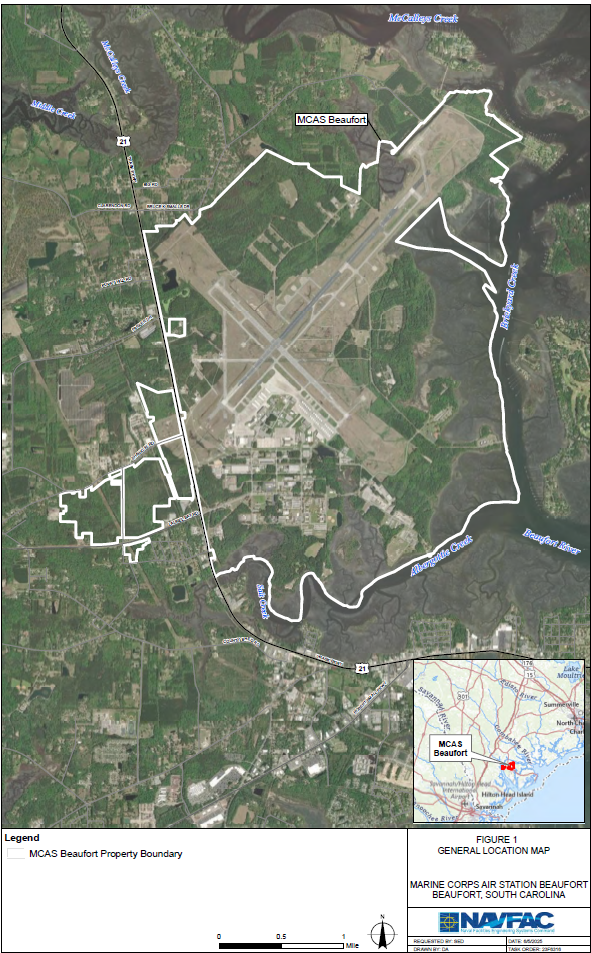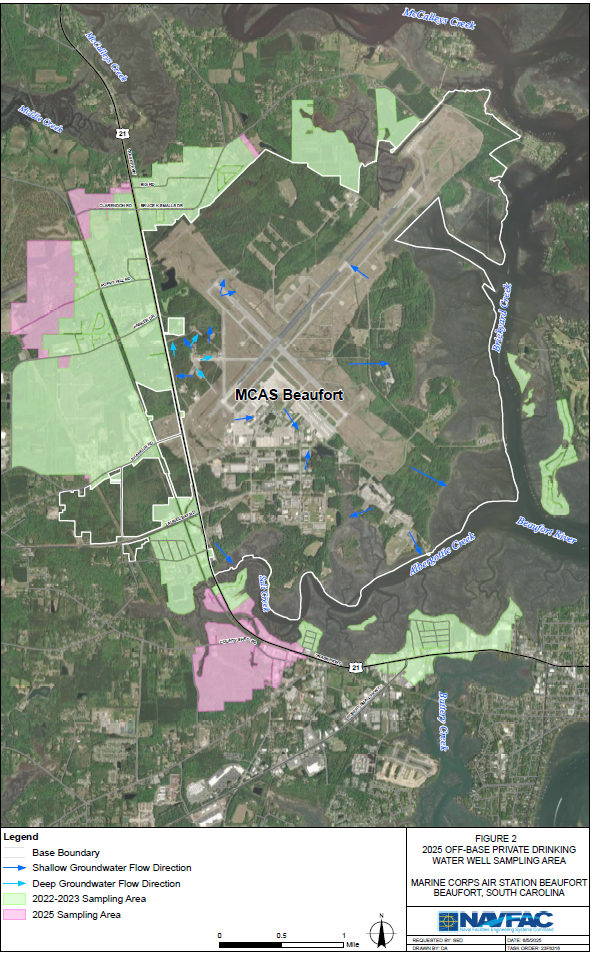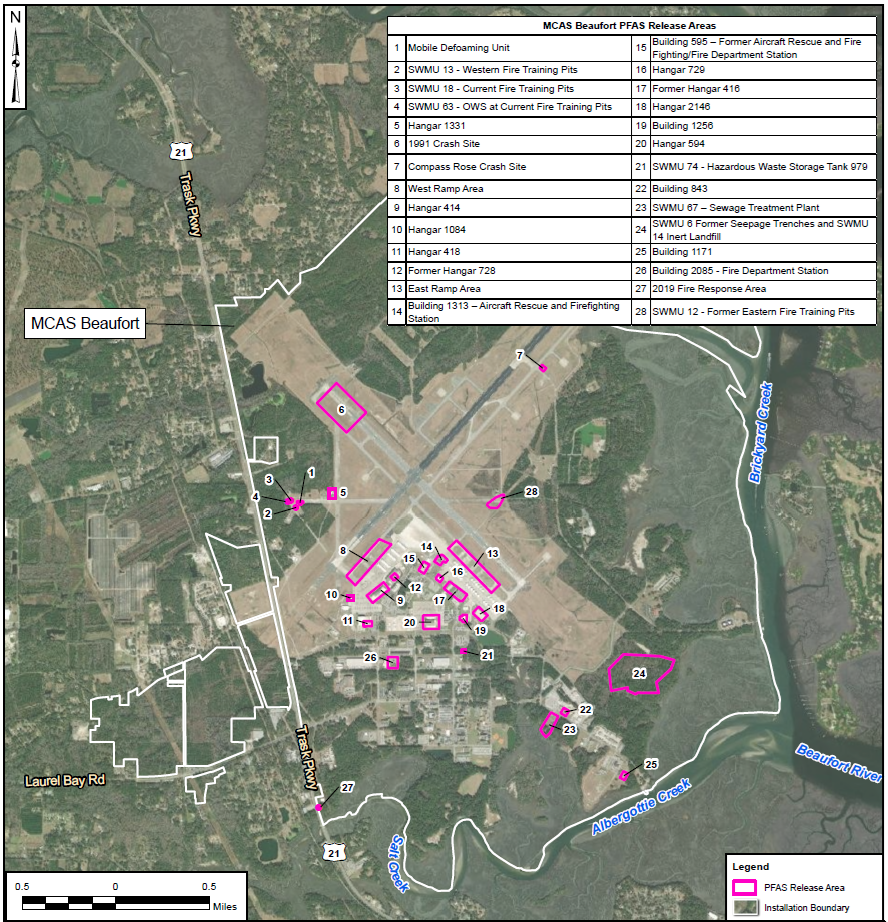The Navy and Marine Corps are requesting property owner permission to sample private drinking water wells for per- and polyfluoroalkyl substances, or PFAS, within sampling areas near Marine Corps Air Station Beaufort.
|
Property owners with a drinking water well in the sampling areas may call 800-687-2560 to schedule a sampling appointment. Appointments are currently being scheduled between 8:00 a.m. and 5:00 p.m. from August 4th, 2025 to August 15th, 2025 (additional times available upon request).
If you have questions about the drinking water well sampling, please email:
bfrt_commstrat@usmc.mil or call and leave a detailed message at 800-687-2560. A Navy and Marine Corps representative will return your call.
If your drinking water is provided by Beaufort-Jasper Water and Sewer Authority, the Navy and Marine Corps do not need to sample your drinking water well.
|
Introduction
PFAS are a family of thousands of different chemicals that have been used since the 1950s in many household and industrial products because of their stain- and water-repellent properties. PFAS are now present virtually everywhere in the world because of the large amounts that have been manufactured and used. Once these compounds are released, many of them tend to stay in the environment for a very long time. The Navy, Marine Corps, and Department of Defense (DoD) have developed policies to address past releases of PFAS at installations nationwide.
The most common activity that could have resulted in the historical release of PFAS to the environment at Marine Corps Air Station (MCAS) Beaufort (Figure 1) is the use of firefighting foam (specifically, aqueous film-forming foam, or AFFF) for testing, training, firefighting, and other life-saving emergency responses. Because of this historical use, PFAS are present in the groundwater at MCAS Beaufort and have also been detected in nearby drinking water wells away from MCAS Beaufort that are located in the direction that the groundwater flows.
Figure 1 - Base Location Map

On April 26, 2024, the United States Environmental Protection Agency (EPA) published a final National Primary Drinking Water Regulation (NPDWR) establishing nationwide drinking water standards for certain PFAS under the Safe Drinking Water Act. The regulation applies to public drinking water systems. Operators of public drinking water systems regulated by the NPDWR have until April 2029 to meet these standards. In September 2024, DoD published “Prioritization of Department of Defense Cleanup Actions to Implement the Federal Drinking Water Standards for Per- and Polyfluoroalkyl Substances under the Defense Environmental Restoration Program,” which describes DoD’s plans to incorporate the EPA’s drinking water regulations into DoD’s ongoing PFAS cleanups and prioritize actions to address private drinking water wells with the highest levels of PFAS from DoD activities. Table 1 shows the levels that all of DoD, including the Navy and Marine Corps, is authorized to use to address PFAS in private drinking water wells.
Table 1 presents the DoD PFAS Interim Action Levels for Private Drinking Water Wells. The DoD’s September 2024 memorandum can be found here.
Table 1. DoD PFAS Interim Action Levels for Private Drinking Water Wells
| PFAS |
Level |
| perfluorooctanoic acid (PFOA) |
12 ppt |
| perfluorooctane sulfonic acid (PFOS) |
12 ppt |
| perfluorononanoic acid (PFNA) |
30 ppt |
| perfluorohexane sulfonic acid (PFHxS) |
30 ppt |
| hexafluoropropylene oxide dimer acid (HFPO-DA or GenX) |
30 ppt |
| hazard index for mixture of at least two of PFHxS, PFNA, HFPO-DA, and perfluorobutane sulfonic acid (PFBS) |
3 (no units) |
ppt = part(s) per trillion
If EPA updates applicable requirements, DoD will review and update its policy as appropriate.
Private Drinking Water Well Sampling near MCAS Beaufort
Certain PFAS have been detected in groundwater at MCAS Beaufort above the DoD PFAS Interim Action Levels for Private Drinking Water Wells. The Navy and Marine Corps continue to collect additional information about groundwater flow at MCAS Beaufort through ongoing investigations. Based on the Navy and Marine Corps’ current understanding of groundwater flow at MCAS Beaufort, an expanded sampling area has been established 1 mile in the direction that groundwater flows away from on base locations with detections at or above the DoD PFAS Interim Action Levels for Private Drinking Water Wells and ½ mile in the direction that groundwater flows away from off base private drinking water wells with detections at or above the DoD PFAS Interim Action Levels for Private Drinking Water Wells (Figure 2).
At this time, the Navy and Marine Corps are requesting property owner permission to sample private drinking water wells located in the combined 2022-2023 and 2025 sampling areas (Figure 2), including those that were previously sampled by the Navy and Marine Corps in 2022-2023 (Figure 2). Records indicate that some properties within the sampling areas receive drinking water from Beaufort-Jasper Water and Sewer Authority (BJWSA). If your drinking water is provided by BJWSA, the Navy and Marine Corps do not need to sample your drinking water. Property owners and tenants should contact their drinking water provider (BJWSA) with any questions regarding its treatment and testing of drinking water.
Figure 2 - Sampling Area

Actions Based on Private Drinking Water Well Sampling Results
The preliminary results from the private drinking water well sampling are expected approximately 30 days after collecting the samples. Once the Navy and Marine Corps receive the preliminary drinking water sample results, the Navy and Marine Corps will call property owners (and tenants, if present) to provide the preliminary drinking water sample results and any follow-up actions, if needed.
The Navy and Marine Corps will address PFAS in private drinking water wells in keeping with the DoD policy:
PFAS at or above the DoD PFAS Interim Actions Levels for Private Drinking Water Wells (Table 1). The Navy and Marine Corps will work with property owners to implement an enduring solution as soon as possible. Options for enduring solutions may include connection to public water supply or installation of a drinking water treatment system. For any drinking water wells with PFOA and PFOS, individually or combined, above 70 ppt, the Navy and Marine Corps will provide bottled water for drinking and cooking to property owners or tenants until a more enduring solution is implemented.
PFAS below the DoD PFAS Interim Action Levels for Private Drinking Water Wells (Table 1). For final remedial actions, the Navy and Marine Corps will address drinking water down to EPA NPDWR or background levels in accordance with Comprehensive Environmental Response, Compensation, and Liability Act (CERCLA) requirements.
2022 - 2023 Private Drinking Water Well Sampling
Between 2022 and 2023, the Navy and Marine Corps sampled 18 private drinking water wells based on information that was available at that time about potential PFAS releases at MCAS Beaufort. The 2022 - 2023 sampling area, shown in Figure 2, was established 1 mile in the direction that groundwater flows away from the release areas shown in Figure 3. Table 2 provides a summary of the results of the 2022 - 2023 sampling. There were no detections of PFOA and/or PFOS above 70 ppt, the Navy and Marine Corps’ action level at the time. Table 3 presents the PFAS results for individual wells in the 2022 - 2023 sampling area. The Navy and Marine Corps have re-evaluated the 2022 - 2023 off-base private drinking water well results using the current DoD PFAS Interim Action Levels for Private Drinking Water Wells (Table 1) and new on base groundwater flow information. One (1) private drinking water well near MCAS Beaufort contains PFAS at or above these levels. The Navy and Marine Corps are working with the property owner to implement an enduring solution.
Table 2. MCAS Beaufort – 2022 - 2023 Private Drinking Water Well Results Summary
| Number of Wells Sampled Between 2022 - 2023 |
Number of Wells with No Detections of PFOA or PFOS |
Number of Wells with Detections of PFAS Below the 2024 DoD PFAS Interim Action Levels for Private Drinking Water Wells |
Number of Wells with Detections of PFAS at or Above the 2024 DoD PFAS Interim Action Levels in Private Drinking Water Wells |
Number of Wells with Detections of PFOA and/or PFOS Above 70 ppt1 |
| 18 |
12 |
5 |
1 |
0 |
1 70 ppt for PFOA and PFOS, individually or combined, was the Navy and Marine Corps’ action level at the time of this sampling.
Table 3. MCAS Beaufort – 2022 - 2023 Private Drinking Water Well Results
| Sample |
PFOA (ppt) |
PFOS (ppt) |
PFOA+PFOS (ppt) |
PFNA (ppt) |
PFHxS (ppt) |
HFPO-DA (ppt) |
PFBS (ppt) |
HI |
| 1 |
ND |
ND |
ND |
ND |
ND |
ND |
ND |
NC |
| 2 |
ND |
ND |
ND |
ND |
ND |
ND |
ND |
NC |
| 3 |
ND |
ND |
ND |
ND |
ND |
ND |
ND |
NC |
| 4 |
ND |
ND |
ND |
ND |
ND |
ND |
ND |
NC |
| 5 |
ND |
ND |
ND |
ND |
ND |
ND |
ND |
NC |
| 6 |
ND |
ND |
ND |
ND |
ND |
ND |
ND |
NC |
| 7 |
ND |
ND |
ND |
ND |
ND |
ND |
ND |
NC |
| 8 |
ND |
ND |
ND |
ND |
ND |
ND |
ND |
NC |
| 9 |
ND |
ND |
ND |
ND |
ND |
ND |
ND |
NC |
| 10 |
ND |
ND |
ND |
ND |
ND |
ND |
ND |
NC |
| 11 |
ND |
ND |
ND |
ND |
ND |
ND |
ND |
NC |
| 12 |
ND |
ND |
ND |
ND |
ND |
ND |
ND |
NC |
| 13 |
ND |
0.558 J |
NC |
ND |
ND |
ND |
0.686 J |
NC |
| 14 |
0.389 J |
0.456 J |
0.845 J |
ND |
ND |
ND |
ND |
NC |
| 15 |
0.809 J |
0.384 J |
1.19 J |
ND |
0.874 J |
ND |
ND |
NC |
| 16 |
1.49 J |
0.613 J |
2.10 J |
ND |
0.664 J |
ND |
ND |
NC |
| 17 |
4.22 |
7.65 |
11.9 |
0.580 J |
4.720 |
ND |
0.966 J |
0.6 |
| 18 |
19.3 J |
0.486 J |
19.8 J |
0.630 J |
4.890 J |
ND |
9.370 J |
0.7 |
Hazard Index. Calculated for HFPO-DA, PFBS, PFNA, and PFHxS when two or more of these compounds are detected in the samples. More information on calculation of the HI.
J = laboratory estimated value
NC = Not Calculated. PFOA+PFOS is only calculated when both are detected. Hazard Index is only calculated when two or more of HFPO-DA, PFBS, PFNA, and PFHxS are detected.
ND = Not Detected
ppt = parts per trillion
Identification of PFAS Releases at MCAS Beaufort
A PFAS Preliminary Assessment (PA) and PA Addendum, finalized in 2020 and 2023 (CDM-AECOM Multimedia Joint Venture, 2020 and 2023a), identified areas where releases of PFAS may have occurred. Based on the results of the PFAS PA and PA Addendum, a PFAS Site Inspection (SI) (CDM-AECOM Multimedia Joint Venture, 2023b) was completed. Sample collection and analysis of groundwater and soil were conducted from December 2021 to November 2022. PFAS were found in groundwater and soil at MCAS Beaufort. The PFAS sites investigated at MCAS Beaufort are listed below in Table 4 and are shown on Figure 3. Remedial investigations are ongoing at the areas of interest (AOIs) indicated in Table 4.
Table 4. MCAS Beaufort – PFAS Release Areas
| Sites |
Building/Area Name |
Area of Interest |
| 1 |
Fire Training Area Site: Mobile Defoaming Unit |
01* |
| 2 |
SWMU 13 - Western Fire Training Pits |
| 3 |
SWMU 18 - Current Fire Training Pits |
| 4 |
SWMU 63 - Oil Water Separator (Crash Fire Rescue Burn Pit) |
| 5 |
Hangar 1331 |
| 6 |
1991 Crash Site |
02* |
| 7 |
Compass Rose Crash Site |
03 |
| 8 |
West Ramp Spill Area (SWMU 69) |
04 |
| 9 |
Hangar 414 |
| 10 |
Hangar 1084 |
| 11 |
Hangar 418 |
| 12 |
Hangar 728 |
| 13 |
East Ramp Spill Area (SWMU 68) |
05 |
| 14 |
Building 1313 – Aircraft Rescue and Firefighting Station |
| 15 |
Building 595 – Former Aircraft Rescue and Fire Fighting/Fire Department Station |
| 16 |
Hangar 729 |
| 17 |
Hangar 416 |
| 18 |
Hangar 2146 |
| 19 |
Hangar 1256 |
| 20 |
Hangar 594 |
| 21 |
SWMU 74 – Hazardous Waste Storage Tank 979 |
06 |
| 22 |
Building 843 |
07 |
| 23 |
SWMU 67 – Sewage Treatment Plant |
08 |
| 24 |
SWMUs 6 & 14 – Inert Landfill Seepage Trenches/Inert Landfill |
09* |
| 25 |
Building 1171 |
10 |
| 26 |
Building 2085 - Fire Department Station |
11 |
| 27 |
2019 Fire Response Area |
12 |
| 28 |
SWMU 12 – Former Eastern Fire Training Pits |
13* |
* = Ongoing remedial investigation
SWMU = Solid Waste Management Unit
The Navy and Marine Corps will continue investigating PFAS at MCAS Beaufort following the CERCLA process and will evaluate if actions are needed. To find out more about all of the environmental investigations at MCAS Beaufort, visit MCAS Beaufort Administrative Record.
Figure 3 – MCAS Beaufort PFAS Release Areas

MCAS Beaufort Private Drinking Water Well Sampling Documents
Private Drinking Water Well Sampling Fact Sheet
Drinking Water Well Questionnaire
Right of Entry Agreement for Sampling of Drinking Water Well(s)
Frequently Asked Questions Drinking Water Sampling for PFAS
Within Sampling Area, but No Private Drinking Water Well Postcard
Postcard to Tenants
Links
DoD PFAS website
EPA PFAS website
ATSDR PFAS website